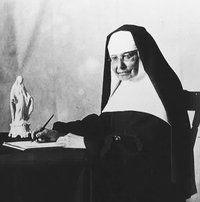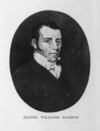
Source: Link
GAGNÉ, MALVINA (baptized Marie-Éléonore-Malvina), named Saint-Raphaël, teacher, Ursuline, founder and superior of the monastery in Roberval, Que., and agricultural consultant; b. 6 Nov. 1837 in Saint-Michel, near Quebec City, daughter of Joseph Gagné, a master pilot, and Luce Mercier; d. 29 Dec. 1920 in Roberval.
Malvina Gagné was only two years old when her father lost his life in a storm on the St Lawrence. Her mother became a seamstress to support their four children. After four years of widowhood, she married a merchant sailor, Prudent Lacombe, and the family was able to live more comfortably. In her early schooling at Saint-Michel, Malvina proved a good student. She often spent the summer on her uncle’s farm, where she developed an interest in agriculture.
Malvina Gagné began her career as a teacher at the age of 15 on the Île d’Orléans. She returned to Saint-Michel the following year for further studies in mathematics and drawing. At 17 she went to Isle-Verte, accompanied by her elder sister, and took up teaching again. There she met Abbé Jean-Lazare Marceau, to whom she confided her desire to become a nun. On 15 Aug. 1861 she entered the Ursuline monastery in Quebec City; several months later, on 21 November, she took the habit and received the name of Mother Saint-Raphaël. She made perpetual vows on 21 Nov. 1863. A graduate of the normal school run by the Ursulines, she impressed her mathematics teacher, François-Xavier Toussaint*, who, according to her biographer Sister Irène-Marie Fortin, observed that she had the “mind of a man” for the subject.
By turns in charge of the infirmary and the pharmacy, a teacher, and sacristan or assistant depositary, Mother Saint-Raphaël was training herself for the role of founder that lay ahead. In 1878 she became mistress of the noviciate in Chatham, Ont. On returning to Quebec City in 1880, she scarcely had time to prepare herself for the new mission that took her to the Lac Saint-Jean area in the spring of 1882.
She went there accompanied by three nuns and with the title of superior; her task was to found a monastery in Roberval that would foster religious vocations and the education of girls, thereby supporting the colonization movement in the region. After a difficult trip lasting several days, the sisters were welcomed by parish priest Joseph Lizotte on 23 May 1882. Although construction of the monastery had begun the year before, it was not finished and the building was barely habitable. The nuns lived in dire poverty for three years, sharing the unenviable lot of the settlers.
Realizing the local needs, Mother Saint-Raphaël decided to adjust the curriculum and add practical training for the role which awaited the girls – that of wife to a pioneer or farmer. According to writer Alphonse Désilets, her decision marked the beginning of “the first domestic science and agricultural school in the country.” Initially the household science school co-existed with the boarding-school; although emphasizing its specialty, it also provided courses from the regular curriculum. At the boarding establishment students received an education similar to that offered in other convents, but they could also get a smattering of domestic science. This regular program enabled graduates to take the examinations of the Catholic Central Board of Examiners, which led to teaching certificates.
During the first decade at Roberval, relations between the founder and the sisters at Quebec remained friendly and were indeed warm. Mother Saint-Raphaël had to deal with numerous persistent problems, however: debt, understaffing, and even disasters such as the fire that destroyed the convent and school on 6 Jan. 1897 and killed seven of her colleagues. Such difficult circumstances galvanized her eager spirit, energy, and enterprise, forcing her to draw on her talents for administration and business. Her innovative solutions sometimes shocked the Quebec monastery, which called her to order. In humility and submission, she obeyed each time.
The domestic science school made remarkable progress, and it reputedly even served as a model for similar ones being developed in Europe. In 1893 it was officially recognized by the government, and so could receive small operating grants and scholarships. Over the years the curriculum expanded to include agricultural science and techniques, and the monastery farm became a real laboratory for practical experiments. Mother Saint-Raphaël worked closely with agronomists from the Department of Agriculture and Colonization, and she became an adviser of sorts for local farmers, indeed, “the agronomist of this region,” according to Alphonse Désilets. It was not surprising that between 1892 and 1895 she twice received an Order of Agricultural Merit medal for the farm’s achievements.
Having served in various capacities, including depositary and director of the farm, in 1900 Mother Saint-Raphaël was re-elected superior of the monastery for six years. She took advantage of her office to begin construction of a new boarding-school and a chapel. By the time she was relieved of her duties as superior, she was nearly 70 years old; from then on she worked in the bursary and taught a few catechism classes. The courses offered at the boarding-school and at the domestic science school were combined in 1909, creating a new household science program affiliated with the Université Laval. By 1910 Mother Saint-Raphaël’s health was deteriorating; at 73 she was losing her sight and could no longer continue her official activities, but she remained a valued adviser. In 1919 disaster struck again when the household science school burned down. After five difficult years, however, the efforts of the Ursulines would be rewarded by the construction of a normal school combined with a household science establishment. Their educative mission would be permanently assured.
When Mother Saint-Raphaël died in 1920, Le Progrès du Saguenay (Chicoutimi) said that her life “was part of the history of the region.” Founder of an Ursuline monastery and an educational institution, she had created a model for the education of girls, including both domestic science and agricultural training, that spread throughout Quebec and even abroad. It was a formula adapted to the needs of women in pioneering situations, who were being asked to devote themselves to the land and home and to encourage others to do so. An innovative administrator, she had had to champion her projects vigorously while maintaining the humility and sense of humour that fostered warm relations with the Quebec City nuns. Consultant to farmers and “agronomist,” she was truly a nation-builder. In the wake of her endeavours, farm clubs were set up for women, and graduates of Roberval played an active role in them. Father Lizotte, who accompanied her throughout her pioneering adventure, considered her “the most perfect woman, the most worthy nun” he had ever met in his years as a priest.
ANQ-Q, CE2-5, 6 nov. 1837, 13 févr. 1843. Arch. du Monastère des Ursulines (Québec), 1/J2,3,3, vol.I (corr. de Malvina Gagné de Saint-Raphaël). M.-E. Chabot, “Les ursulines de Roberval, pionnières au diocèse de Chicoutimi,” in Évocations et témoignages: centenaire du diocèse de Chicoutimi, 1878–1978 (Chicoutimi, Qué., 1978), 179–89. Alphonse Désilets, Histoire de mère Saint-Raphaël, ursuline de Québec . . . , introd. de C.-F. Delage (Québec, 1932). I.-M. Fortin, Les pionnières: les ursulines à Roberval de 1882 à 1932 (Saint-Nazaire, Qué., 1982).
© 1998–2024 University of Toronto/Université Laval
Image Gallery

Cite This Article
Nicole Thivierge, “GAGNÉ, MALVINA, Saint-Raphaël,” in Dictionary of Canadian Biography, vol. 14, University of Toronto/Université Laval, 2003–, accessed April 23, 2024, http://www.biographi.ca/en/bio/gagne_malvina_14E.html.
The citation above shows the format for footnotes and endnotes according to the Chicago manual of style (16th edition). Information to be used in other citation formats:
| Permalink: | http://www.biographi.ca/en/bio/gagne_malvina_14E.html |
| Author of Article: | Nicole Thivierge |
| Title of Article: | GAGNÉ, MALVINA, Saint-Raphaël |
| Publication Name: | Dictionary of Canadian Biography, vol. 14 |
| Publisher: | University of Toronto/Université Laval |
| Year of publication: | 1998 |
| Year of revision: | 1998 |
| Access Date: | April 23, 2024 |








